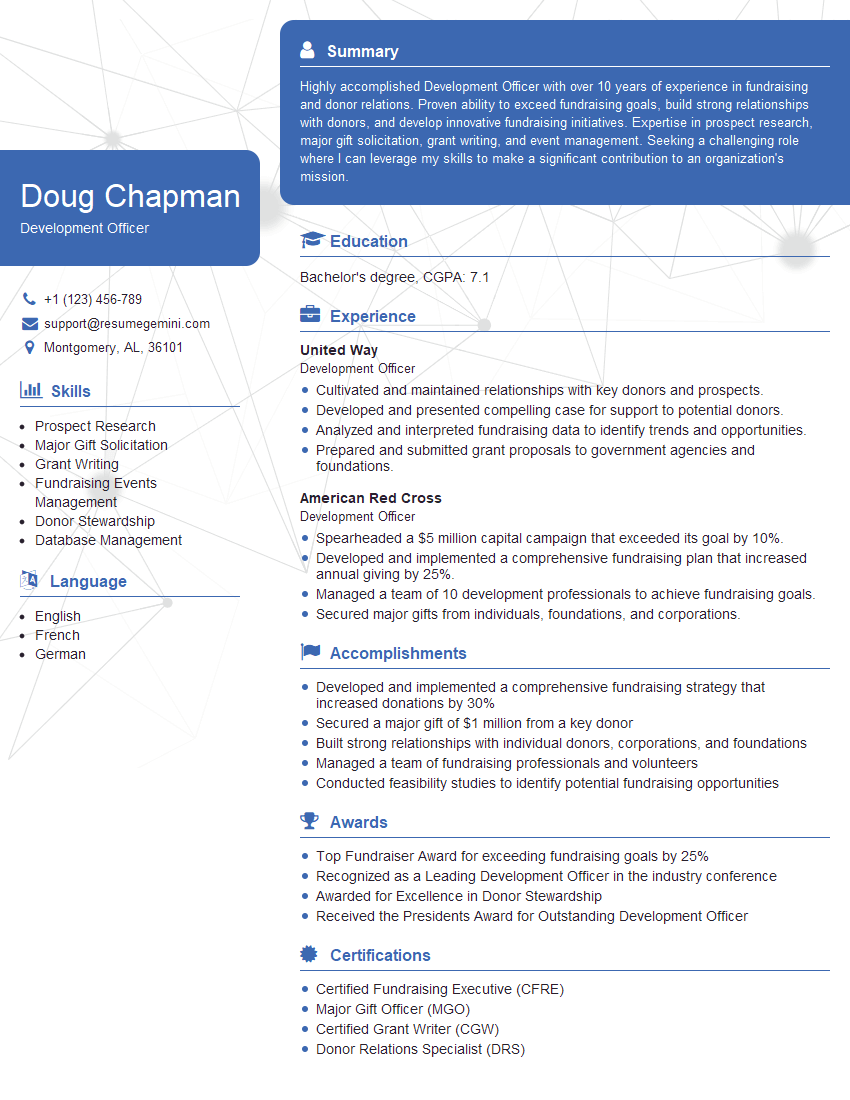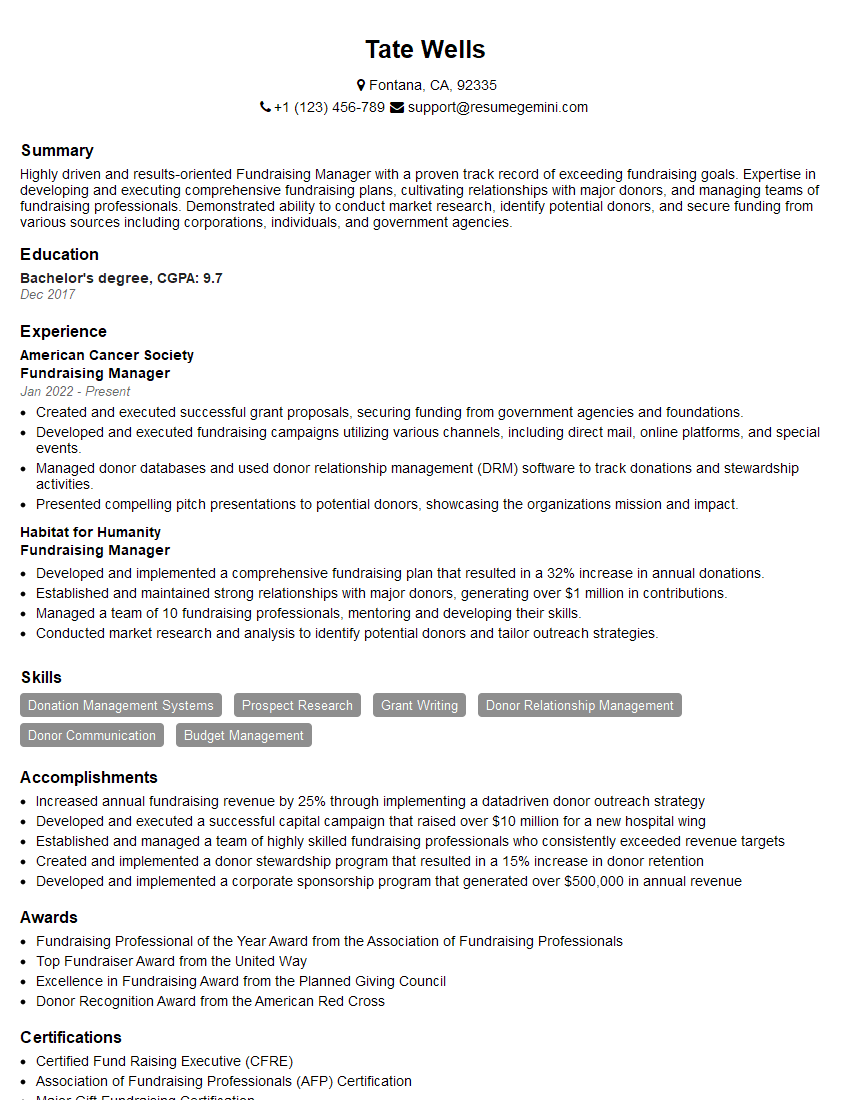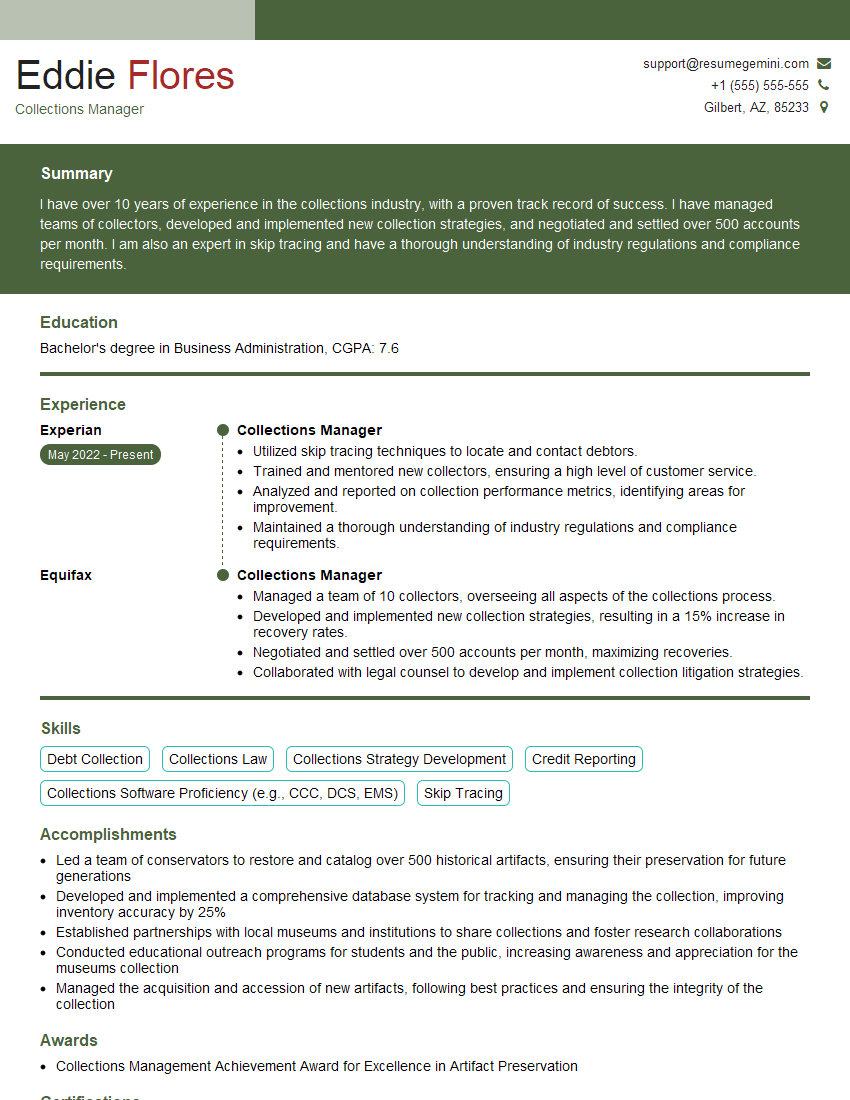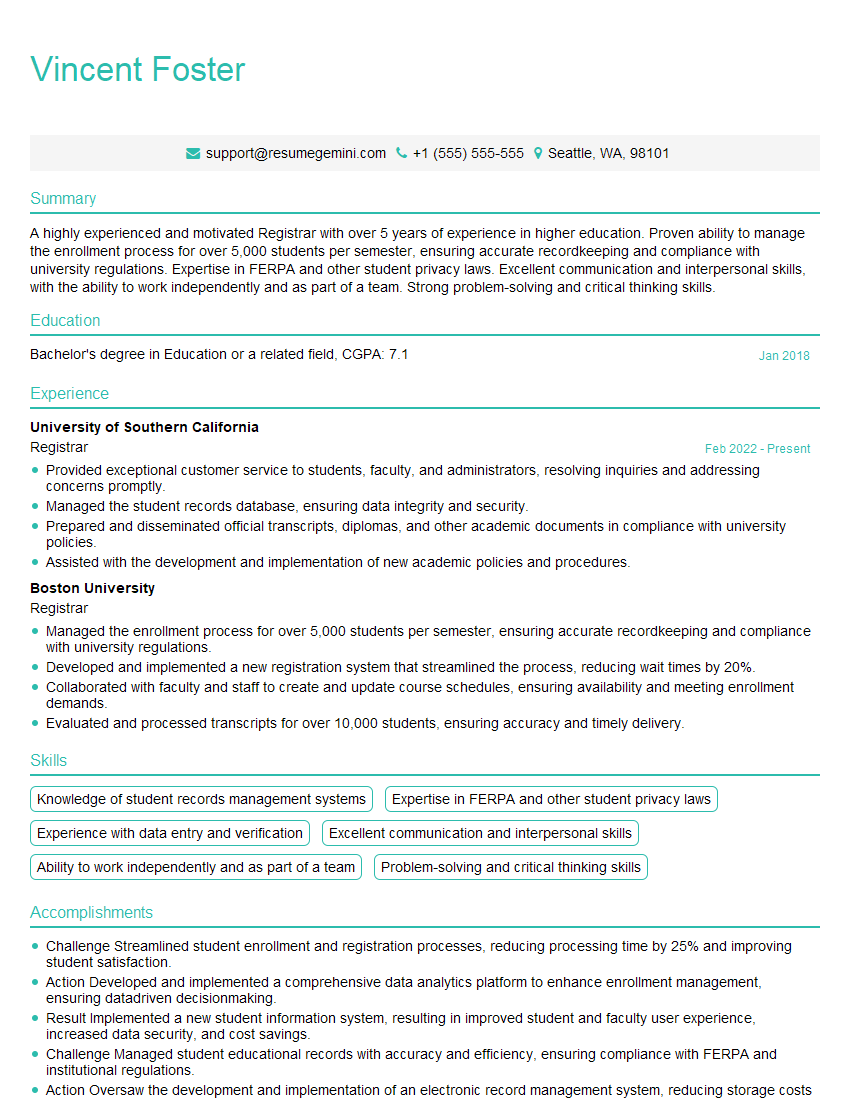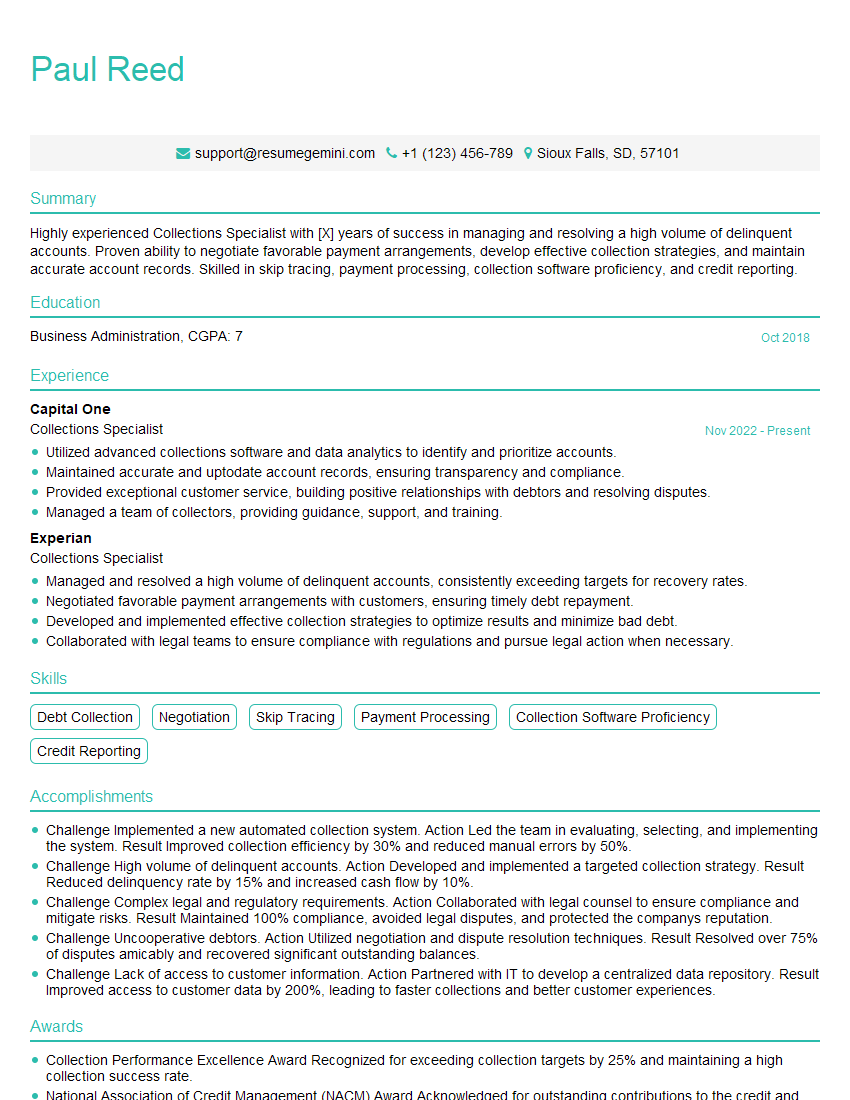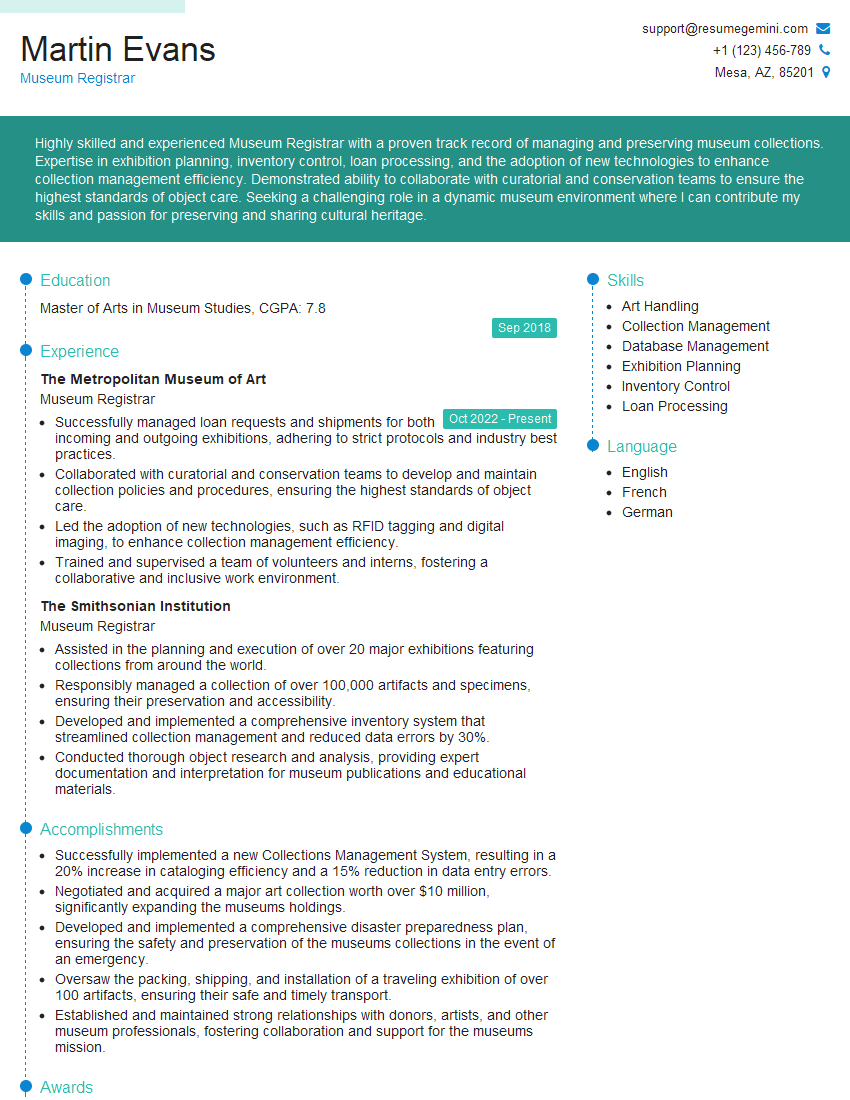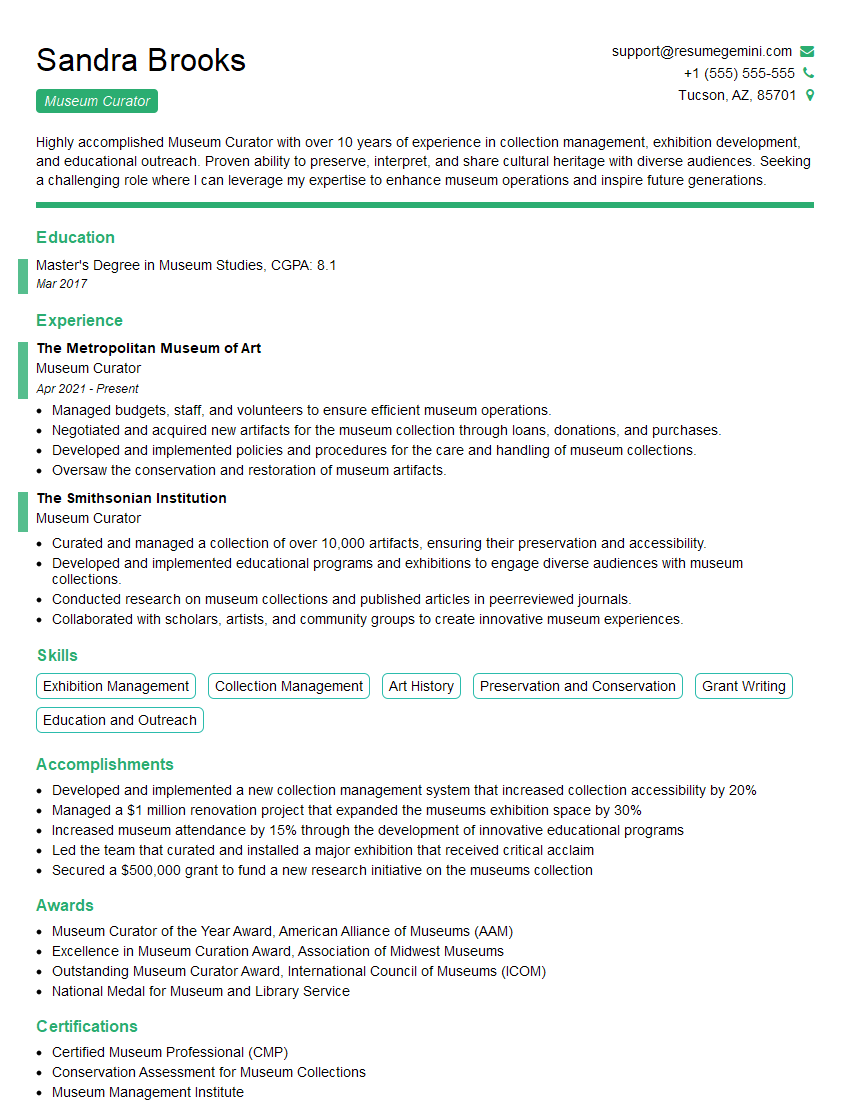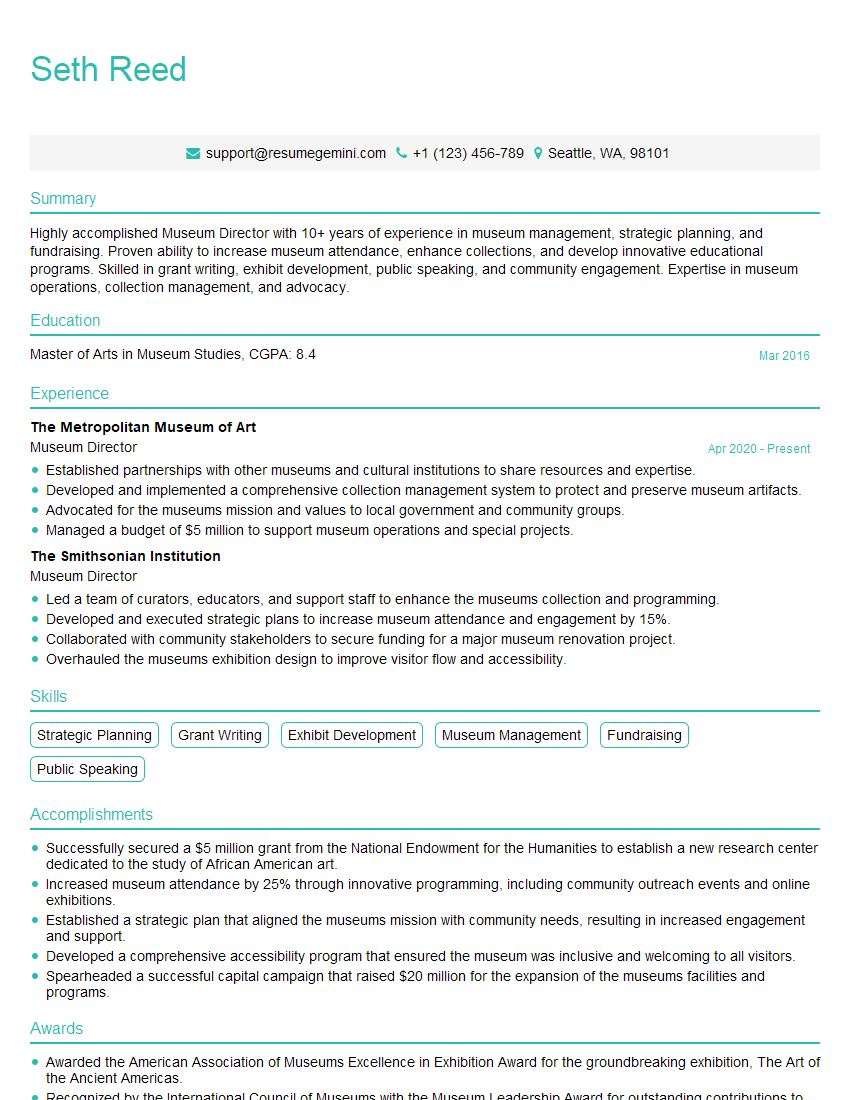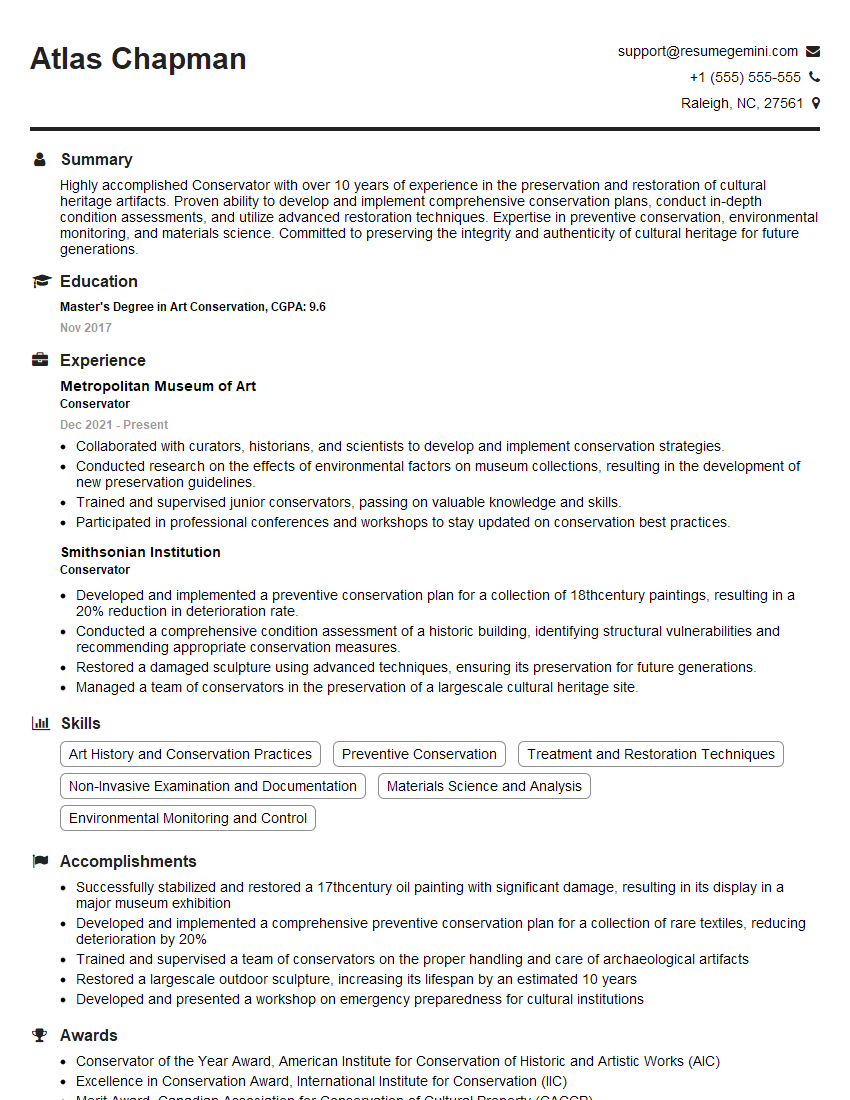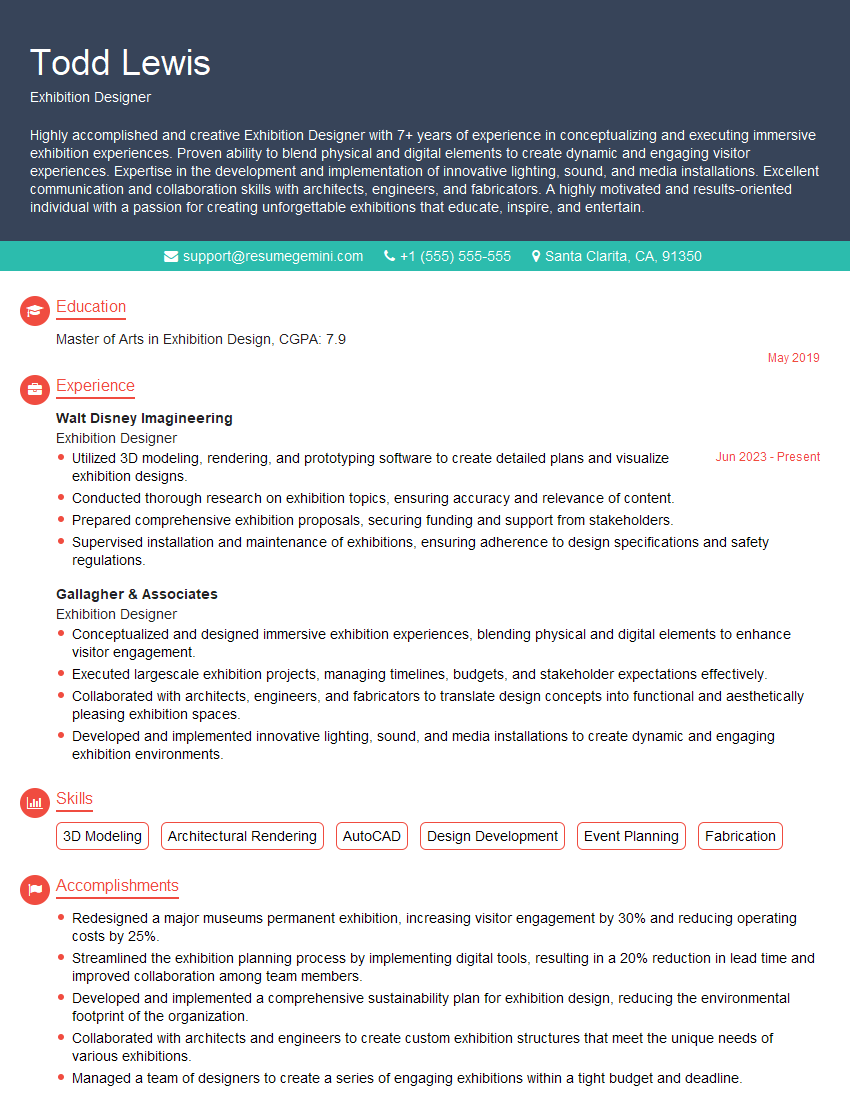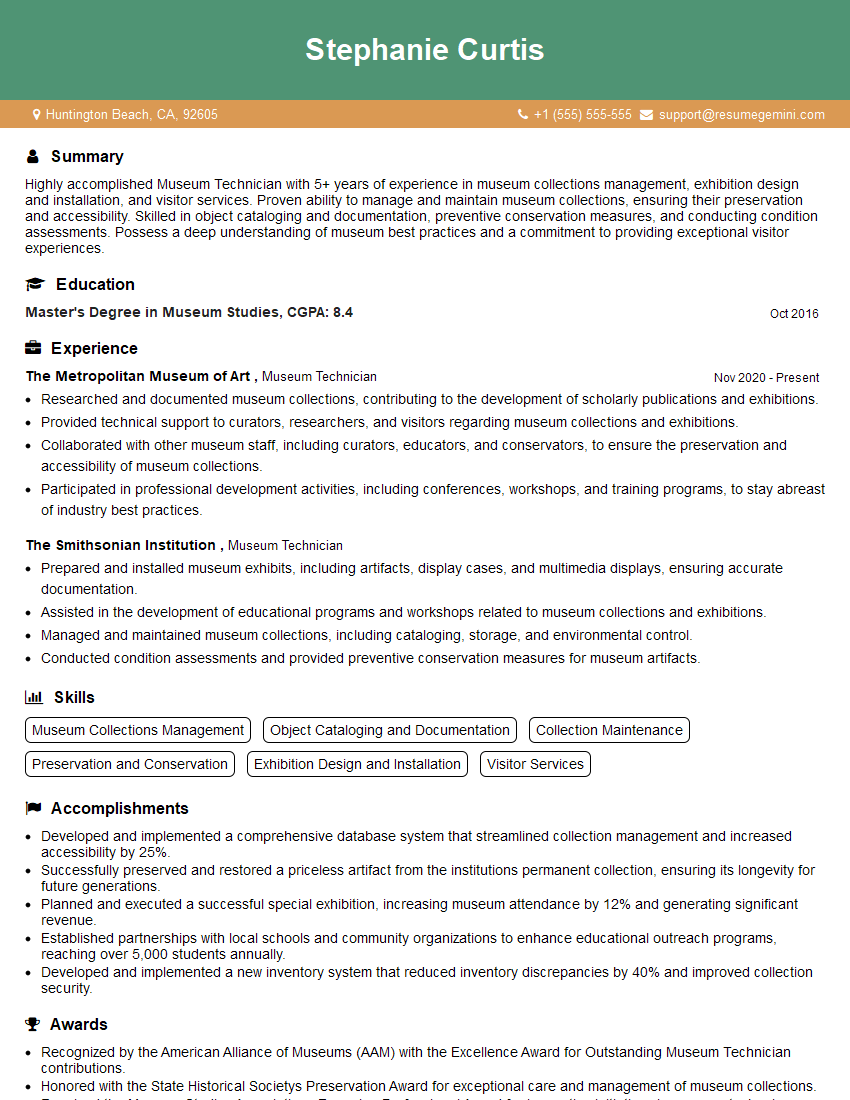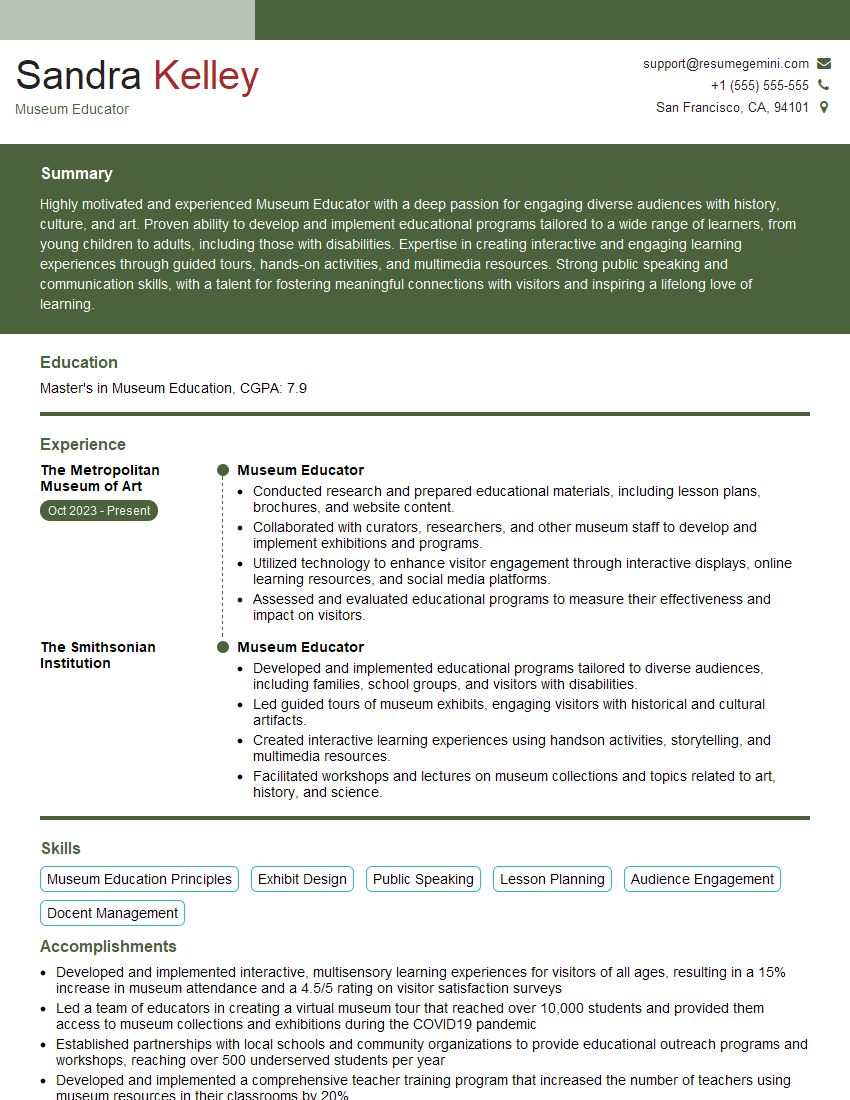Every successful interview starts with knowing what to expect. In this blog, we’ll take you through the top Collaboration with Museum Professionals interview questions, breaking them down with expert tips to help you deliver impactful answers. Step into your next interview fully prepared and ready to succeed.
Questions Asked in Collaboration with Museum Professionals Interview
Q 1. Describe your experience collaborating with conservators on exhibition projects.
Collaborating with conservators is crucial for successful exhibition projects. Conservators possess specialized knowledge about artifact handling, preservation, and environmental controls, which are paramount to preventing damage and ensuring the long-term health of museum collections. My experience involves a multi-stage process: early discussions to understand the artifact’s condition and limitations, joint development of display plans that prioritize preservation, ongoing communication throughout the installation process, and post-installation monitoring.
For example, during the ‘Ancient Egypt’ exhibition, I worked closely with the chief conservator to determine the optimal lighting levels for fragile papyrus scrolls. This involved extensive testing and discussions to balance visitor experience with the need to minimize light-induced degradation. The result was a beautifully lit display case that successfully showcased the scrolls without jeopardizing their longevity.
Another example involves collaborating on the mounting of a delicate porcelain vase. We jointly determined the best type of mounting system to ensure stability and minimize stress on the artifact during transport and display. Regular check-ins and thorough documentation of each step were essential in this collaboration.
Q 2. How have you successfully resolved conflicts between different museum departments?
Resolving conflicts between museum departments often requires a diplomatic and collaborative approach that prioritizes the overall goals of the institution. It’s rarely about assigning blame but instead focusing on finding solutions that accommodate the needs and perspectives of all involved parties.
I typically employ a structured approach: I begin by facilitating open communication, where each department explains their concerns and priorities. I then encourage active listening and empathy. Once all viewpoints are understood, I focus on identifying common ground and areas of overlap. Compromise is key. It’s about finding creative solutions that might not perfectly satisfy every party, but represent a fair and functional outcome for the entire project.
During the planning of a major renovation, for instance, disagreements arose between the curatorial and facilities departments regarding the optimal placement of new display cases. By bringing both teams together, facilitating a discussion about accessibility, security, and aesthetic concerns, we collaboratively designed a layout that satisfied both departments’ needs.
Q 3. Explain your approach to managing diverse teams within a museum environment.
Managing diverse teams within a museum necessitates fostering a culture of inclusivity, respect, and open communication. Each individual brings unique skills and perspectives, and leveraging this diversity is crucial for success. My approach involves establishing clear roles and responsibilities from the outset to avoid confusion. This is coupled with regular team meetings to facilitate open dialogue and brainstorming sessions, which allow all team members to contribute their expertise.
I strongly believe in providing regular feedback, both positive and constructive, to each team member. I also actively seek out and value diverse viewpoints, even when they challenge the status quo. This promotes a sense of psychological safety, where individuals feel comfortable sharing their thoughts and ideas without fear of judgment. Regular social events can also help foster better team cohesion.
For a recent exhibition about global textiles, my team included textile experts, historians, designers, and educators. By leveraging the diverse skill sets of each team member, we successfully developed an immersive exhibition that appealed to a wide range of audiences.
Q 4. Describe a situation where you had to negotiate competing priorities among team members.
During the development of an interactive exhibit about local history, the design team wanted to incorporate a complex augmented reality element while the education department prioritized simpler, hands-on activities for younger visitors. These competing priorities threatened to derail the project.
My approach involved a structured negotiation process. First, I facilitated a meeting with all stakeholders to clearly define each department’s goals and concerns. I then worked with the team to explore compromise solutions. This resulted in a revised design that incorporated a scaled-down augmented reality component alongside the hands-on activities, satisfying both teams’ needs. Regular check-ins throughout the design and development phase ensured everyone stayed aligned with the revised plan and potential issues were addressed early on.
Q 5. How do you ensure effective communication across different departments in a museum?
Effective cross-departmental communication is the backbone of successful museum operations. I employ a multi-pronged strategy incorporating various communication channels and methods to cater to different preferences and needs. Regular meetings, email updates, and project management software are crucial. However, I also believe that informal channels of communication such as team lunches or casual check-ins are important in fostering strong working relationships.
We use a project management system to track progress, assign tasks, and share documents across departments. This ensures everyone has access to the most up-to-date information and can easily track progress. This platform encourages transparency and minimizes misunderstandings.
Q 6. What strategies do you employ to build consensus within a team working on a museum exhibit?
Building consensus involves a participatory process that ensures everyone feels heard and valued. I employ strategies like brainstorming sessions, where team members can freely share ideas without immediate judgment. This is followed by a structured discussion where we evaluate each idea against pre-defined criteria such as feasibility, budget, and alignment with the exhibition’s overall goals. I utilize visual aids like mind maps and flowcharts to clarify ideas and build a shared understanding.
When disagreements arise, I facilitate respectful dialogue and encourage compromise. Sometimes, voting or ranking exercises can help reach a decision. Ultimately, it’s about finding a solution that most of the team can support, even if it isn’t everyone’s preferred option. Transparency throughout the process is paramount; everyone should understand the rationale behind the final decision.
Q 7. How do you handle disagreements regarding the interpretation or presentation of museum artifacts?
Disagreements about artifact interpretation or presentation are common, and resolving them requires a nuanced approach that prioritizes academic rigor, ethical considerations, and visitor understanding. I encourage a collaborative discussion using primary source material and relevant scholarship. We might involve specialists from different fields, such as historians, anthropologists, or archaeologists, to ensure a balanced and informed interpretation.
For instance, during an exhibition on indigenous art, disagreements arose about the context and presentation of certain artifacts. By bringing in cultural advisors and community representatives, we were able to develop an interpretation that respectfully acknowledged multiple perspectives. This involved careful selection of language, context, and imagery, ensuring that the presentation was sensitive, accurate and inclusive.
Q 8. Describe your experience working with external stakeholders (e.g., lenders, sponsors).
Working with external stakeholders like lenders and sponsors requires a delicate balance of professionalism, transparency, and proactive communication. It’s crucial to build strong, trusting relationships based on mutual respect and shared goals. My approach involves clearly defining expectations from the outset, regularly updating stakeholders on progress (both successes and challenges), and actively seeking their feedback throughout the process.
For example, when collaborating with a lender for a major exhibition, I ensured we had a detailed loan agreement outlining all aspects of care, transportation, insurance, and publicity. We established a clear communication protocol with regular meetings and email updates. This proactive approach not only minimized potential conflicts but also fostered a sense of partnership, resulting in a successful exhibition that benefited both the museum and the lender. With sponsors, I focus on clearly articulating the value proposition for their investment, highlighting opportunities for brand alignment and showcasing the impact of their contribution to the museum’s mission. This includes providing regular reports and acknowledging their support publicly.
Q 9. How do you foster a collaborative and inclusive work environment within a museum team?
Fostering a collaborative and inclusive environment within a museum team is paramount. It’s about creating a space where every team member feels valued, respected, and empowered to contribute their unique skills and perspectives. I achieve this through several strategies:
- Open and honest communication: Regular team meetings, both formal and informal, allow for open dialogue, brainstorming sessions, and the sharing of ideas. I actively encourage feedback and ensure everyone feels comfortable expressing their opinions.
- Shared decision-making: Where appropriate, I involve the team in decision-making processes, ensuring their input shapes the direction of projects. This fosters a sense of ownership and engagement.
- Recognizing and celebrating successes: Acknowledging individual and team accomplishments, both big and small, boosts morale and reinforces positive behavior.
- Diversity and inclusion initiatives: Promoting diversity within the team and implementing policies to foster an inclusive environment where everyone feels welcome and respected is essential.
- Conflict resolution: Establishing clear guidelines for conflict resolution and providing training on effective communication and conflict management techniques ensures that disagreements are addressed constructively.
For example, in one instance, I implemented a team-building activity centered around collaborative problem-solving, which helped break down hierarchical barriers and foster a more unified approach to project work.
Q 10. Explain your experience using collaborative project management tools in a museum setting.
Collaborative project management tools are indispensable in a museum setting, allowing for streamlined communication, efficient task management, and enhanced transparency across teams and departments. I’ve had extensive experience using platforms like Asana, Trello, and Microsoft Teams.
For instance, when organizing a large-scale exhibition, we used Asana to manage individual tasks, deadlines, and team assignments. Each team member had a clear overview of their responsibilities, and progress could be tracked in real-time. This helped prevent bottlenecks and ensured that the project stayed on schedule. Microsoft Teams provided a central platform for communication, allowing for quick updates, file sharing, and virtual meetings. This was especially crucial during periods of remote work.
Q 11. How do you ensure that all team members understand their roles and responsibilities?
Ensuring everyone understands their roles and responsibilities is crucial for effective collaboration. I achieve this through clear role definition and communication.
- Detailed job descriptions: Creating detailed job descriptions outlining roles, responsibilities, and reporting lines ensures that everyone is clear about their tasks.
- Team meetings and project briefings: Regular team meetings and project briefings provide opportunities to discuss roles and responsibilities, address any questions, and ensure everyone is on the same page.
- Project charters and work plans: Developing comprehensive project charters and work plans that outline roles, responsibilities, timelines, and deliverables enhances clarity and provides a shared understanding of expectations.
- Regular check-ins: Regular check-ins with team members offer an opportunity to address any concerns or ambiguities, ensuring everyone stays on track.
A practical example is assigning a project manager for every exhibition who is responsible for coordinating all aspects of the project, delegating tasks based on individual skills and expertise, and reporting progress to the senior management team. This clear structure helps prevent confusion and promotes efficiency.
Q 12. Describe a time you had to adapt your collaboration style to meet the needs of a specific team.
In one instance, I had to adapt my collaboration style when working with a team that preferred a more informal and decentralized approach to decision-making. My usual style involves structured meetings and clear reporting lines, but this team functioned more effectively through open dialogue and collaborative brainstorming sessions.
To meet their needs, I adapted my approach by facilitating more informal discussions and incorporating their input throughout the decision-making process. Instead of dictating specific tasks, I encouraged a more organic approach where team members took ownership of tasks and projects based on their interests and expertise. This resulted in a highly engaged and motivated team, delivering successful results.
Q 13. How do you measure the success of collaborative projects in a museum context?
Measuring the success of collaborative projects in a museum context goes beyond simply completing the project on time and within budget. It requires a holistic approach that considers multiple factors:
- Project outcomes: Did the project achieve its intended goals? Were the planned deliverables met? Were the key performance indicators (KPIs) achieved?
- Team satisfaction: Were team members satisfied with the collaboration process? Did they feel valued and empowered? Were conflicts resolved effectively? Feedback surveys and post-project reviews can provide valuable insights.
- Visitor engagement: In the case of exhibitions or events, measuring visitor engagement (attendance figures, visitor feedback surveys, social media engagement) helps assess the project’s impact on the museum’s audience.
- Impact on museum goals: Did the project contribute to achieving the museum’s strategic goals, such as increased brand awareness, visitor numbers, or community engagement?
For example, a successful exhibition would be measured by attendance figures, positive visitor reviews, media coverage, and the achievement of fundraising targets. The team’s satisfaction would be gauged through feedback surveys and informal discussions.
Q 14. What are the key challenges in collaborating with volunteers in a museum setting?
Collaborating with volunteers in a museum setting presents unique challenges. The key challenges often involve:
- Managing diverse skill levels and experience: Volunteers often have varying levels of experience and expertise, requiring careful task assignment and training.
- Maintaining consistency and quality: Ensuring consistent quality of work across different volunteers requires clear guidelines, regular supervision, and effective communication.
- Balancing volunteer time commitment with project needs: Volunteers have varying levels of time commitment, making it challenging to coordinate schedules and deadlines.
- Providing appropriate training and support: Volunteers require adequate training and ongoing support to successfully perform their assigned tasks.
- Recognition and appreciation: Recognizing and appreciating the valuable contributions of volunteers is essential for maintaining motivation and engagement.
To overcome these challenges, it’s crucial to develop a clear volunteer management plan, provide comprehensive training, establish clear communication channels, and offer regular feedback and recognition.
Q 15. How do you build trust and rapport among team members in a museum environment?
Building trust and rapport in a museum environment, much like any team, hinges on open communication, mutual respect, and shared goals. It’s about creating a psychologically safe space where individuals feel comfortable contributing their ideas and expertise without fear of judgment.
- Transparency: Regular team meetings, transparent decision-making processes, and honest communication about project challenges and successes are vital. For instance, keeping everyone updated on budget allocation and timeline adjustments proactively prevents misunderstandings and fosters trust.
- Active Listening: Truly hearing and valuing the perspectives of each team member, regardless of their role or seniority, is crucial. Organizing informal brainstorming sessions or team-building activities can encourage open dialogue and help people connect on a personal level.
- Recognition and Appreciation: Acknowledging individual and team achievements, both big and small, strengthens morale and boosts team cohesion. Publicly thanking team members for their hard work during staff meetings or sending individual notes of appreciation can go a long way.
- Conflict Resolution: Addressing conflicts promptly and fairly is critical. Establishing clear protocols for resolving disagreements, perhaps through mediation or facilitated discussions, helps ensure that disputes don’t damage team relationships.
For example, during a recent exhibition installation, a disagreement arose between the conservators and the designers regarding the lighting arrangement. By facilitating a discussion where each party explained their concerns and collaboratively found a compromise, we avoided a potentially disruptive conflict and instead solidified the team’s trust in each other’s expertise.
Career Expert Tips:
- Ace those interviews! Prepare effectively by reviewing the Top 50 Most Common Interview Questions on ResumeGemini.
- Navigate your job search with confidence! Explore a wide range of Career Tips on ResumeGemini. Learn about common challenges and recommendations to overcome them.
- Craft the perfect resume! Master the Art of Resume Writing with ResumeGemini’s guide. Showcase your unique qualifications and achievements effectively.
- Don’t miss out on holiday savings! Build your dream resume with ResumeGemini’s ATS optimized templates.
Q 16. Explain your understanding of intellectual property rights in the context of museum collaboration.
Intellectual property rights (IPR) in museum collaboration are paramount. They cover a range of rights protecting creative works and inventions, impacting everything from exhibition designs to the digitization of artifacts. Understanding these rights is crucial to ensure legal compliance and ethical practices.
- Copyright: This protects original artistic works, including photographs, exhibition designs, and written materials. Clear copyright agreements are essential when collaborating with external artists or designers.
- Trademark: This protects brand names and logos, particularly important for museum branding and merchandise. Collaboration agreements should specify the usage rights of trademarks.
- Moral Rights: These rights grant creators control over how their work is presented and attributed, even after transferring copyright. Respect for these rights is vital for maintaining ethical collaborations.
- Database Rights: These are relevant when working with digital collections or large databases of museum information. Collaboration agreements must address the use and sharing of such data.
Consider a collaborative project with a university researching a specific artifact. Before the research begins, a robust agreement needs to be drafted outlining who owns the copyright for resulting publications, images, and data derived from the artifact’s study. This agreement should explicitly define the rights of the museum and the university regarding the dissemination and commercial use of the project’s outputs.
Q 17. How do you incorporate feedback from various stakeholders into a museum project?
Incorporating feedback from various stakeholders is key to successful museum projects. This involves actively seeking input from diverse groups, including visitors, staff, community members, sponsors, and academic partners. A structured approach is essential to manage and synthesize this feedback effectively.
- Surveys and Questionnaires: These are effective for gathering quantitative data and understanding visitor preferences or staff opinions on a particular aspect of a project.
- Focus Groups: These provide in-depth qualitative feedback through moderated discussions with selected stakeholders. This allows for deeper exploration of opinions and identifying underlying issues.
- Public Forums and Community Engagement Events: These events enable direct interaction with the community, garnering feedback and building support for the project.
- Feedback Forms and Online Platforms: Providing online channels for feedback encourages continuous improvement and allows for easy data collection.
- Analysis and Synthesis: After collecting feedback, it’s crucial to analyze the data, identifying key themes and areas for improvement. Summarizing the key findings and recommending actionable steps demonstrates a commitment to stakeholder involvement.
For example, while planning a new children’s exhibit, we employed surveys for visitor preferences, focus groups with educators, and community engagement events. Analyzing this multifaceted feedback shaped the final design, making it engaging, educational, and inclusive.
Q 18. Describe your experience in facilitating workshops or meetings within a museum setting.
Facilitating workshops and meetings in a museum setting requires a blend of organizational skills, communication proficiency, and cultural sensitivity. The goal is to create an environment conducive to collaborative brainstorming, constructive critique, and effective decision-making.
- Clear Objectives and Agenda: Defining clear objectives for each workshop or meeting and sharing a detailed agenda beforehand ensures focused discussions.
- Interactive Activities: Incorporating group exercises, brainstorming sessions, or small group discussions encourages active participation and fosters a sense of collaboration.
- Effective Communication: Utilizing visual aids, presentations, and clear and concise language enhances understanding and engagement.
- Time Management: Sticking to a pre-determined schedule keeps meetings on track and respects participants’ time.
- Constructive Feedback Mechanisms: Setting up methods for constructive feedback, such as anonymous feedback forms or structured debriefing sessions, ensures that all perspectives are considered.
For instance, when facilitating a workshop on the design of a new exhibition, I used a combination of presentations, group discussions, and interactive exercises involving the handling of replica artifacts. This approach generated a wide range of ideas and fostered a collaborative design process.
Q 19. How do you manage competing deadlines and priorities during a collaborative museum project?
Managing competing deadlines and priorities in collaborative museum projects demands a structured approach and strong communication. Proactive planning, effective prioritization, and regular monitoring are key to success.
- Project Management Tools: Using project management software (e.g., Asana, Trello) to track tasks, deadlines, and responsibilities helps maintain clarity and organization.
- Prioritization Matrix: Employing a prioritization matrix (e.g., Eisenhower Matrix) to rank tasks by urgency and importance aids in efficient allocation of resources and time.
- Regular Check-ins and Progress Reports: Conducting regular team meetings and providing progress reports keeps everyone informed and enables early identification and mitigation of potential delays.
- Risk Management: Identifying potential risks and developing contingency plans helps mitigate unexpected challenges and keeps the project on track.
- Flexible Approach: Recognizing that unforeseen circumstances can arise, maintaining a degree of flexibility is important to adapt to changing circumstances.
In a recent exhibition project, we faced delays in the delivery of key artifacts. By leveraging our risk management plan and proactively communicating with all stakeholders, we adjusted the timeline, re-prioritized tasks, and successfully launched the exhibition despite the unforeseen challenge.
Q 20. How do you ensure the ethical considerations are addressed in collaborative museum work?
Ethical considerations are fundamental in collaborative museum work. They encompass issues related to cultural sensitivity, repatriation, intellectual property, data privacy, and environmental sustainability.
- Cultural Sensitivity: Collaborations should respect the cultural heritage and traditions associated with artifacts and stories being shared. Consultation with relevant indigenous communities or cultural experts is often necessary.
- Repatriation: Museums need to engage in respectful discussions around the return of artifacts to their rightful owners or places of origin.
- Intellectual Property Rights: Collaborations must adhere to copyright, trademark, and other intellectual property laws, ensuring fair use and proper attribution.
- Data Privacy: Handling visitor data, staff information, and research data ethically and responsibly is crucial, adhering to data protection regulations.
- Environmental Sustainability: Collaborative projects should strive to minimize their environmental impact, considering sustainable practices in design, construction, and operations.
For example, while working on an exhibition featuring indigenous artifacts, we ensured close consultation with the relevant community to gain their input on how the artifacts were displayed and the narrative was presented, guaranteeing respectful and ethical representation.
Q 21. What is your approach to delegation and assigning tasks within a museum team?
Delegation in a museum team requires careful consideration of individual skills, experience, and workload. It’s about empowering team members to take ownership and develop their capabilities.
- Skill Matching: Assign tasks to team members based on their strengths and expertise. This ensures efficient completion and enhances team morale.
- Clear Expectations: Provide clear instructions, deadlines, and performance expectations for each assigned task. This minimizes confusion and enhances accountability.
- Appropriate Authority: Delegate sufficient authority to team members to make decisions and resolve issues within their assigned tasks. Micromanagement hinders efficiency and morale.
- Regular Feedback: Provide regular feedback and support to team members, offering guidance and addressing any challenges they face.
- Recognition and Reward: Acknowledge and reward team members’ contributions to reinforce positive behavior and boost motivation.
For instance, when organizing a large-scale exhibition, I delegated tasks such as cataloging, research, and marketing to different team members based on their specific areas of expertise. By providing clear guidelines and regular feedback, I ensured the successful completion of the project and empowered team members to take ownership of their work.
Q 22. Describe a time you had to mediate a conflict between curatorial and educational staff.
Mediating conflict requires understanding the root cause and facilitating a productive conversation. In one instance, curatorial staff wanted to showcase a delicate artifact in a way the education team felt risked damage. The education team prioritized hands-on learning, while the curatorial team prioritized preservation.
My approach was to first actively listen to both sides, validating their concerns. I then facilitated a brainstorming session focusing on solutions that met both needs. We explored alternative display methods that maximized educational engagement while ensuring the artifact’s safety. This involved finding a balance – a compromise using protective casing combined with detailed interactive displays, allowing for close observation without direct handling.
The key was to reframing the conflict not as opposing viewpoints but as shared goals with differing approaches. The resulting solution was collaborative, demonstrating mutual respect, and improved interdepartmental communication. It also resulted in a better exhibit overall.
Q 23. How do you balance individual contributions with collaborative efforts in a museum team?
Balancing individual contributions with collaborative efforts involves fostering a culture of trust and shared responsibility. In museums, individual expertise is crucial, but teamwork is essential for large-scale projects. I believe in establishing clear roles and responsibilities from the outset. This clarity helps individuals understand their specific contributions within the broader project goals.
Regular team meetings provide opportunities to share updates, address challenges, and ensure everyone feels heard. Open communication, constructive feedback, and recognition of individual achievements reinforce a sense of shared success and contribute to overall morale. For instance, I might delegate specific research tasks to individual team members based on their expertise, then bring everyone together for collaborative interpretation and exhibition design.
Q 24. How do you maintain confidentiality when collaborating on sensitive museum projects?
Maintaining confidentiality on sensitive museum projects requires establishing clear protocols and adherence to strict guidelines. This includes using secure communication channels like encrypted emails for discussions about sensitive information. Access to confidential data should be limited to those with a legitimate need-to-know basis. All sensitive documents and digital files should be password-protected and stored securely.
Furthermore, clear communication about confidentiality expectations at the beginning of a project ensures everyone understands their responsibilities. Regular reminders reinforce this commitment. In cases where external collaborators are involved, confidentiality agreements should be signed before commencing work on any project. This is especially important when dealing with sensitive donor information or artifacts of historical significance.
Q 25. What are your preferred methods for documenting and tracking progress in collaborative museum projects?
Effective documentation and progress tracking in collaborative projects are vital for success. My preferred method incorporates a blend of digital and analog tools. I use project management software like Asana or Trello for task assignment, deadline tracking, and progress visualization. Each project has a dedicated online space accessible to all team members.
For more detailed documentation, I rely on shared online documents like Google Docs or collaborative spreadsheets, allowing everyone to contribute and track changes. Minutes from meetings are meticulously recorded and shared. Regular check-in meetings, often using video conferencing, keep everyone aligned and provide opportunities to address issues promptly. This comprehensive documentation system ensures that everyone is aware of the progress and any changes made throughout the project lifecycle.
Q 26. How do you ensure that all team members feel valued and respected?
Making all team members feel valued and respected hinges on creating an inclusive and supportive environment. I achieve this by practicing active listening and demonstrating genuine interest in each individual’s contributions. I provide regular feedback, both positive and constructive, ensuring it’s tailored to the individual’s needs and development. This feedback is always delivered in a supportive manner, focusing on improvement and growth.
Public recognition of individual and team achievements during meetings or through informal communication helps foster a sense of pride and accomplishment. Creating opportunities for professional development, allowing individuals to take on new challenges or attend relevant workshops, demonstrates investment in their growth. Finally, addressing any concerns or conflicts promptly and fairly shows respect for everyone’s voice and perspective.
Q 27. How do you adapt your communication style to effectively collaborate with individuals from diverse backgrounds?
Adapting communication style to effectively collaborate with individuals from diverse backgrounds is crucial. I begin by actively seeking to understand individual communication preferences. This involves paying attention to verbal and nonverbal cues, considering cultural norms, and being mindful of language barriers. Clear and concise communication is key, avoiding jargon and using accessible language.
I find visual aids and demonstrations particularly helpful in overcoming language barriers. When working with individuals from different cultural backgrounds, I aim to be sensitive to their communication styles. For example, some cultures may prioritize direct communication, while others favor a more indirect approach. Flexibility and patience are essential, as is seeking feedback to ensure my communication is understood and effective. Open dialogue and a willingness to learn from others’ perspectives are critical to successful collaboration.
Q 28. How familiar are you with current best practices in museum collaboration and management?
I’m very familiar with current best practices in museum collaboration and management, including project management methodologies (Agile, Waterfall), collaborative software, and conflict resolution strategies. I stay updated through professional development workshops, conferences, and industry publications. I’m aware of best practices regarding accessibility, inclusion, and ethical considerations in museum work.
I actively participate in professional networks and communities, exchanging insights and best practices with colleagues. My knowledge encompasses strategies for building strong partnerships with community organizations, funders, and other stakeholders. I’m also familiar with the latest research on effective teamwork, leadership, and change management in museum settings. I regularly explore new technologies and approaches that enhance collaboration and efficiency.
Key Topics to Learn for Collaboration with Museum Professionals Interview
- Understanding Museum Structures & Operations: Explore the organizational hierarchy, departmental roles (curatorial, education, development, etc.), and typical workflows within museums of varying sizes and types.
- Effective Communication Strategies: Practice clear, concise communication tailored to different stakeholders (colleagues, curators, volunteers, donors). Consider strategies for handling disagreements and diverse perspectives respectfully and productively.
- Project Management & Collaboration Tools: Familiarize yourself with project management methodologies (Agile, Waterfall) and collaborative tools (e.g., shared document platforms, project management software) frequently used in museum settings. Be prepared to discuss your experience with these, highlighting successful collaborative projects.
- Respecting Collections & Ethical Considerations: Demonstrate understanding of ethical guidelines concerning the handling, preservation, and interpretation of museum collections. This includes awareness of cultural sensitivity and best practices for working with artifacts and archival materials.
- Fundraising & Grant Writing (if applicable): If the role involves fundraising or grant writing, showcase your understanding of the process and relevant skills. Be ready to discuss strategies for securing funding for museum initiatives.
- Data Management & Analysis (if applicable): Depending on the role, be prepared to discuss experience with managing and analyzing museum data, including visitor statistics, collection records, or financial data.
- Problem-Solving & Conflict Resolution: Be prepared to discuss your approach to problem-solving within a collaborative team environment. Highlight situations where you successfully navigated conflicts or disagreements to achieve a positive outcome.
Next Steps
Mastering collaboration with museum professionals is crucial for career advancement in this dynamic field. Strong collaborative skills are highly valued, leading to more fulfilling roles and increased opportunities for growth. To enhance your job prospects, creating an ATS-friendly resume is essential. ResumeGemini is a trusted resource to help you build a compelling and effective resume that showcases your skills and experience to potential employers. Examples of resumes tailored to Collaboration with Museum Professionals are available within ResumeGemini to guide your creation.
Explore more articles
Users Rating of Our Blogs
Share Your Experience
We value your feedback! Please rate our content and share your thoughts (optional).
What Readers Say About Our Blog
Hello,
We found issues with your domain’s email setup that may be sending your messages to spam or blocking them completely. InboxShield Mini shows you how to fix it in minutes — no tech skills required.
Scan your domain now for details: https://inboxshield-mini.com/
— Adam @ InboxShield Mini
Reply STOP to unsubscribe
Hi, are you owner of interviewgemini.com? What if I told you I could help you find extra time in your schedule, reconnect with leads you didn’t even realize you missed, and bring in more “I want to work with you” conversations, without increasing your ad spend or hiring a full-time employee?
All with a flexible, budget-friendly service that could easily pay for itself. Sounds good?
Would it be nice to jump on a quick 10-minute call so I can show you exactly how we make this work?
Best,
Hapei
Marketing Director
Hey, I know you’re the owner of interviewgemini.com. I’ll be quick.
Fundraising for your business is tough and time-consuming. We make it easier by guaranteeing two private investor meetings each month, for six months. No demos, no pitch events – just direct introductions to active investors matched to your startup.
If youR17;re raising, this could help you build real momentum. Want me to send more info?
Hi, I represent an SEO company that specialises in getting you AI citations and higher rankings on Google. I’d like to offer you a 100% free SEO audit for your website. Would you be interested?
Hi, I represent an SEO company that specialises in getting you AI citations and higher rankings on Google. I’d like to offer you a 100% free SEO audit for your website. Would you be interested?
good
